Wavelength-selective diffraction element and an optical head device
a diffraction element and wavelength-selective technology, applied in the direction of optical beam sources, disposition/mounting of heads, instruments, etc., can solve the problems of inability to record or reproduce information, inability to select diffraction efficiency, loss of light quantity and reduce signal intensity, etc., to achieve excellent heat resistance and irradiation resistance, the effect of easy change of diffraction efficiency and easy change of wavelength dispersibility
- Summary
- Abstract
- Description
- Claims
- Application Information
AI Technical Summary
Benefits of technology
Problems solved by technology
Method used
Image
Examples
first embodiment
[0124] (First Embodiment of the Optical Head Device)
[0125] FIG. 8 shows a first embodiment of the optical head device of the present invention in which the optical head device uses the wavelength-selective diffraction element 1A (FIG. 1) for generating 3 beams usable for a CD, as a wavelength-selective diffraction element. In the optical head device thus constructed, light having a wavelength .lambda..sub.1 emitted from a two-wavelength semiconductor laser 3 (which is formed by unifying a semiconductor laser for emitting a laser light having a wavelength of .lambda..sub.1 for a DVD series optical disk and a semiconductor laser for emitting a laser light having a wavelength .lambda..sub.2 for a CD series optical disk) propagates linearly without being diffracted by the wavelength-selective diffraction element 1A and transmits through a beam splitter 4 to enter into a collimator lens 5 where the laser light is rendered to be a parallel beam.
[0126] Then, the parallel beam is focused on...
second embodiment
[0133] (Second Embodiment of the Optical Head Device)
[0134] FIG. 10 shows a second embodiment of the optical head device of the present invention in which the optical head device uses the wavelength-selective diffraction element 1C as a holographic beam splitter. In the optical head device thus constructed, light having a wavelength .lambda..sub.1 emitted from a two-wavelength semiconductor laser 3 for emitting light having wavelength .lambda..sub.1 and wavelength .lambda..sub.2 enters into the holographic splitter where about 70% of the entering light is transmitted, and it is rendered to be a parallel beam by a collimator lens 5. Then, the parallel beam is focused on an information recording track of an optical disk 7 (DVD series) by means of an objective lens 6. The light reflected by the optical disk 7 transmits again through the objective lens 6 and the collimator lens 5 to enter into the wavelength-selective holographic beam splitter. About 10% of light diffracted by the beam ...
eighth embodiment
[0138] (Eighth Embodiment of the Wavelength-Selective Diffraction Element)
[0139] The wavelength-selective diffraction element 1H of this embodiment shown in FIG. 16 comprises the wavelength-selective diffraction element used in the first embodiment provided that the diffraction grating is formed only in its peripheral portion. The wavelength-selective diffraction element 1H is a diffraction element provided with a transparent substrate 11H having a front surface on which a diffraction grating 12H having a concavo-convex portion for a grating (which is comprised of a concavo-convex member) is formed and a filling member 13H filled in the space. A transparent substrate 14H is formed thereon to protect the filling member 13H.
[0140] The refractive index of the diffraction grating 12H is equal to that of the filling member 13H with respect to light having a wavelength .lambda..sub.1 and the refractive index of the diffraction grating 12H is different from that of the filling member 13H w...
PUM
| Property | Measurement | Unit |
|---|---|---|
| wavelength band | aaaaa | aaaaa |
| wavelength band | aaaaa | aaaaa |
| angle | aaaaa | aaaaa |
Abstract
Description
Claims
Application Information
 Login to View More
Login to View More - R&D
- Intellectual Property
- Life Sciences
- Materials
- Tech Scout
- Unparalleled Data Quality
- Higher Quality Content
- 60% Fewer Hallucinations
Browse by: Latest US Patents, China's latest patents, Technical Efficacy Thesaurus, Application Domain, Technology Topic, Popular Technical Reports.
© 2025 PatSnap. All rights reserved.Legal|Privacy policy|Modern Slavery Act Transparency Statement|Sitemap|About US| Contact US: help@patsnap.com



